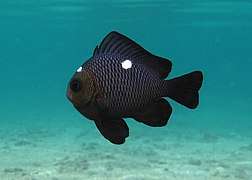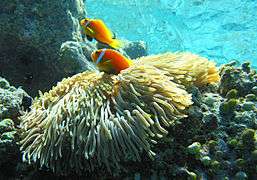Threespot dascyllus
The threespot dascyllus (Dascyllus trimaculatus), also known as the domino damsel or simply domino, is a species of damselfish from the family Pomacentridae. It is native to the Indo-Pacific from the Red Sea and East Africa, to the Pitcairn Islands, southern Japan, and Australia.[1] Its grey to black body has two lateral white spots and one between the eyes like domino hence the name; the threespot dascyllus grows up to 13 cm in length. Coloration is somewhat variable; the spot on the forehead may be absent and the lateral spots very much reduced. It feeds on algae, copepods and other planktonic crustaceans.[2]
| Threespot dascyllus | |
|---|---|
 | |
| Scientific classification | |
| Kingdom: | Animalia |
| Phylum: | Chordata |
| Class: | Actinopterygii |
| Family: | Pomacentridae |
| Genus: | Dascyllus |
| Species: | D. trimaculatus |
| Binomial name | |
| Dascyllus trimaculatus (Rüppell, 1829) | |
| Synonyms | |
Habitat
Generally, adults are found in small groups around coral heads or large rocks. Juveniles may be found associated with large sea anemones or sheltering between the spines of diadema sea urchins or branching corals.[3] This species may be found to depths of 55 m.
Etymology
Trimaculatus, meaning "three-spotted", refers to the fish's three white spots. This accounts also for the common name "domino".[4]

 A pair of juvenile three-spot dascylluses with their anemone in the Maldives: A pair of black-foot anemonefish can be seen to the top.
A pair of juvenile three-spot dascylluses with their anemone in the Maldives: A pair of black-foot anemonefish can be seen to the top. Juvenile threespot dascyllus (left) and a pair of Maldives anemonefish associated with the sea anemone Heteractis magnifica
Juvenile threespot dascyllus (left) and a pair of Maldives anemonefish associated with the sea anemone Heteractis magnifica
References
- Froese, Rainer and Pauly, Daniel, eds. (2007). "Dascyllus trimaculatus" in FishBase. 5 2007 version.
- Allen, G.R., 1991. Damselfishes of the world. Mergus Publishers, Melle, Germany. 271 p.
- Lieske, E. and Myers, R.F. (2004) Coral reef guide; Red Sea London, HarperCollins ISBN 0-00-715986-2
- Siliotti, A. (2002) fishes of the red sea Verona, Geodia ISBN 88-87177-42-2
| Wikimedia Commons has media related to Dascyllus trimaculatus. |
| Wikispecies has information related to Dascyllus trimaculatus |